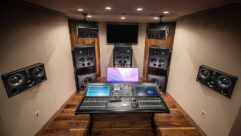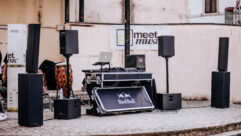One year after installing its first Fairlight Crystal Core (CC-1) system, Milwaukee-based Independent Studios has upgraded its second audio post production suite to encompass CC-1 technology, thus ensuring that projects can move seamlessly from one suite to another.
Since its formation in 1991, Independent Studios has grown from a small, one studio facility specializing in commercial music and sound design to a company handling commercials, documentaries and feature film projects for a wide variety of clients. Its facilities have also grown to include two audio suites – both equipped with Fairlight Constellation consoles – and a music studio. Video editing suites, graphics suites and a new color correction suite are also on site, and these are owned and operated by a separate company, Independent Edit.
Founding director Randy Bobo says: “We have been using Fairlight equipment since 2000, when we installed our first Prodigy 2 and QDC systems. In June 2008 we decided to upgrade one of our audio suites to the new CC-1 platform because we wanted the ability to integrate video into our projects and have the option of third party plug-ins.
“Having made that decision, it was only a matter of time before we also upgraded our second audio post suite and finally retired our remaining QDC. We like to have both post production studios equipped identically because this allows us greater schedule flexibility with our commercial clients. When both rooms are the same, projects can move from one to another very easily, allowing revisions to happen wherever and whenever they need to happen.”?
Although Randy Bobo freely admits that he’s not a ‘Windows person’, he says the transition to Fairlight’s latest technology has been very straightforward and, one year in, he can’t imagine using anything other than CC-1.
“It is so much faster and gives us much more flexibility,”? he says. “Thanks to Fairlight’s support of multiple A/V file formats, we can now import, export and convert files in a fraction of real time. This has made a real difference to our workflow.”?
Ken Barnsley, Fairlight’s Director of World-wide Sales and Marketing, says sales of the CC-1 engine are steadily increasing, especially in the US, as new and existing Fairlight users recognize the power and versatility of this enhanced platform.
“Fairlight’s CC-1 card is undoubtedly a major improvement on our previous QDC platform, particularly in terms of its green credentials,”? Barnsley says. “Physically it has been reduced from the size of a dishwasher to a module that fits in your pocket, while in terms of energy it offers a 98% reduction in overall heat generated and a power reduction from 600 watts to just 12. By supporting a seamless interplay of both HD video and audio and a wide range of file exchange capabilities, Fairlight technology delivers real convergence within one integrated production environment and enhances the workflow in a wide variety of broadcast and post applications.”?
US-based facilities interested in Fairlight products should contact the Fairlight USA office. Telephone: +1 310 923 6419.
-ends-
About Fairlight:
Headquartered in Sydney, Australia Fairlight designs and manufactures media production systems powered by the company’s groundbreaking CC-1 FPGA digital processing engine. The Fairlight product range includes Constellation, Xynergi and the new Pyxis MT, all of which feature in the world’s leading broadcasters, commercial post facilities, music studios and film production studios. Fairlight has a rich tradition of innovation and development and is at the forefront of green computing technology.










